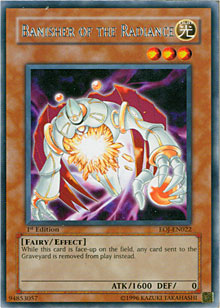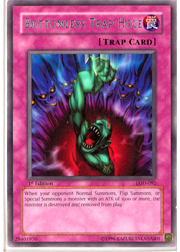This week, we’ll be looking at what I consider to be one of the most definitive decks of anti-metagame play, and by far the most nostalgic deck archetype for me. The truth is, the Yu-Gi-Oh! TCG, like poker, is a reflection of the way people live their lives. The dishonest will play dishonestly, the sheep will herd, and the innovators will strive to do something original. Originality isn’t simply some rebellious need to disassociate with the establishment, a punk song, or a black t-shirt and eyeliner; it’s an acceptance that the only way to make a difference is to do something different. Whether you do this playing cards or in the business world, realize that you’re playing for a chance at the big win.
Gadgets are a statement. They are mathematic, controlling, and intelligent.
The build we’ll be using is heavily focused on turning your opponent’s deck inside-out. A large majority of your matchups will be Dark Armed Dragon decks, Gladiator Beasts, or Lightsworn. For that reason, the main deck will be focused largely on beating those builds. Should you play against any other deck archetype, you’ll address the other matchups after game 1. Most players change their decks to beat others after the first game; we’ll be doing the opposite.
The Monsters
 The monster lineup is rather simple. It begins with three Gadgets, the strengths of which have been discussed countless times. When playing Gadgets, you basically have a monster to play every turn. The only problem is that the monsters are weak, and the rest of your deck must be geared for you to take advantage of the stability created by a constant stream of monsters. This also means that your monster count can be very small, as you only need to draw a single Gadget to have access to a monster for eight turns.
The monster lineup is rather simple. It begins with three Gadgets, the strengths of which have been discussed countless times. When playing Gadgets, you basically have a monster to play every turn. The only problem is that the monsters are weak, and the rest of your deck must be geared for you to take advantage of the stability created by a constant stream of monsters. This also means that your monster count can be very small, as you only need to draw a single Gadget to have access to a monster for eight turns.
However, you won’t draw a Gadget in every opening hand. In theory, you should have a Gadget a large majority of the time, as one in (just over) every seven cards is a Gadget. For every time you don’t have a Gadget, you have another nine monsters in your deck. Each of them has the ability to severely limit your opponent’s options. Thunder King Rai-Oh has become a notorious anti-meta card, even being featured as tech in Dark Armed Dragon and Gladiator Beast builds. King Tiger Wanghu limits a Gladiator Beast deck by stopping them from playing Test Tiger, an incredible advantage. With many builds no longer playing Elemental Hero Prisma, the deck is left with very few outs. It also stops the special summon of Destiny Hero – Malicious and Krebons, which can halt a Dark Armed Dragon deck in its tracks. Banisher of the Radiance stops the use of Gladiator Beast Darius, limiting the play of Gladiator Beast Gyzarus. It also stops Malicious, and all the graveyard manipulation of TeleDAD. As for Lightsworn . . . you’re opponent will be hard pressed to respond.
The Spells
The spell lineup is rather small, and mostly focused on monster removal.
Notice that a majority of the removal is chainable, though Fissure and Smashing Ground are too good to pass up. The three "off" cards are Dimensional Fissure, which serves the same purpose as Banisher of the Radiance. Having a copy of Dimensional Fissure behind King Tiger Wanghu or Thunder King Rai-Oh early in the game can make for a very quick victory.
The Traps
 The trap lineup offers a more diverse range of options than the other two parts of the deck.
The trap lineup offers a more diverse range of options than the other two parts of the deck.
Mirror Force, Dimensional Prison, and Bottomless Trap Hole serve a similar function in the deck, protecting your monsters so you can take advantage of the anti-meta tendencies of the rest of the deck. Playing Gadgets makes you dependent on monster removal. Other decks use their monsters to serve this purpose: Gladiator Beasts use Gyzarus, Gladiator Beast Murmillo or Gladiator Beast Laquari; TeleDAD decks will either use Dark Armed Dragon, or simply run over your monsters with a Synchro monster; Lightsworn decks will run similar to Dark Armed Dragon decks. Much to their credit, this is a much more efficient manner of destroying monsters than using direct monster removal spells and traps. However, this inefficiency is more than compensated for in a Gadget deck, because the monsters you are protecting represent direct "card advantage" or indirect control over your opponent. Thus, when you play Dimensional Prison on your opponent’s monster, you don’t just destroy something; you also protect the control your monsters already have over the game.
Royal Oppression is one of the most powerful anti-meta cards in the game, and it would be foolhardy to forget it. It immediately limits all three of your target opponents’ decks, making the summon of many of their monsters impossible. In a Gladiator Beast deck that relies almost completely on special summons, you only have to destroy the opponent’s copies of Laquari to win the game. Against Dark Armed Dragon or Lightsworn, there’s very little that can be done to stop you. Solemn Judgment protects these situations which you create, and stops the large plays that your opponent attempts.
When playing this deck, you’re more concerned with your opponent’s cards than your own. You want to identify your opponent’s deck, and respond by playing to combinations of anti-meta cards that stop his or her early-game play patterns. Against Gladiator Beasts, your monster removal will go a long way. Try to bait out a Gladiator Beast Gyzarus if you have Bottomless Trap Hole or Solemn Judgment. You’ll want to save a copy of King Tiger Wanghu or Thunder King Rai-Oh for the mid or late game, when your opponent is shy of cards. Banisher of the Radiance is best played in the early game. Against Dark Armed Dragon, you’re going to want to stop an explosive early game. Stopping Dark Armed Dragon is a matter of lasting a couple turns. Such decks want to win quickly; if you stop that from happening, you’ve probably won yourself. Against Lightsworn decks, you’ll want to play and protect Banisher of the Radiance for as long as possible.
Remember to continue with free, uninhibited invention. Be introspective and improve yourself; don’t assume that the thought processes of the masses are the best. It takes originality and innovation to truly succeed. If Yu-Gi-Oh! offers anything, it offers the thought process necessary to do those things. Remember to keep playing that game, no matter how long you play this one.
-Ryan Murphy